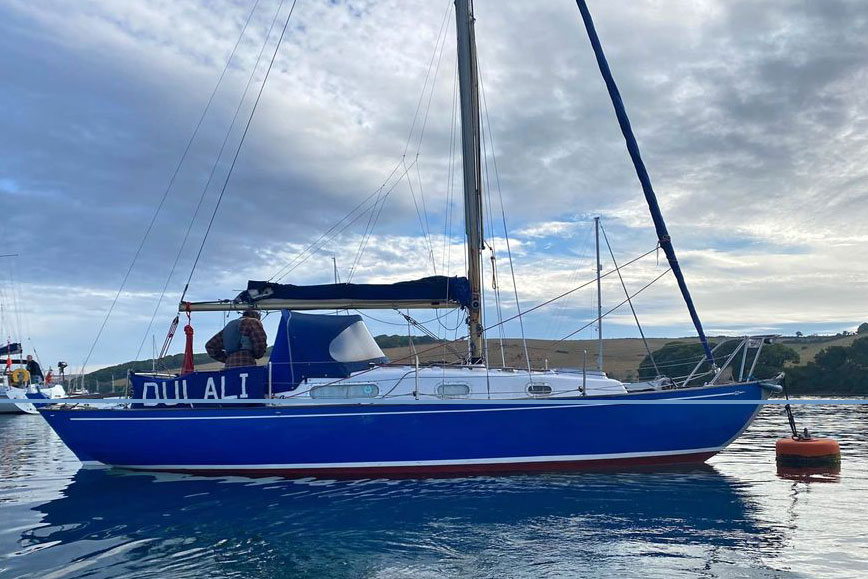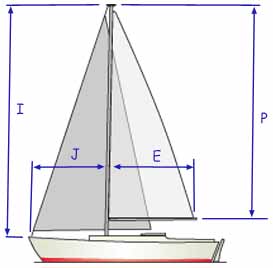- Home
- Cruiser Yachts under 30'
- Contessa 26 Sailboat Specs
The Contessa 26 Sailboat
Specs & Key Performance Indicators
The Contessa 26 sailboat, designed by British naval architect David Sadler, is a classic long-keel vessel constructed from fiberglass. Initially built by Jeremy Rogers Limited in Lymington, UK, production later continued with J.J. Taylor & Sons Ltd in Canada.
 The Contessa 26, a heavy-displacement long-keel cruiser
The Contessa 26, a heavy-displacement long-keel cruiserPublished Specification for the Contessa 26
Keel & Rudder Configuration: Long keel with transom-hung rudder
Hull Material: Fiberglass
Length Overall: 7.77m (25'6")
Waterline Length: 6.40m (21'0")
Beam: 2.29m (7'6")
Draft: 1.22m (4'0")
Rig Type: Masthead sloop
Displacement: 2,449 kilograms (5,400 pounds)
Ballast: 1,043 kilograms (2,300 pounds)
Water Tank Capacity: Varies, often around 45 litres (12 gallons)
Fuel Tank Capacity: Varies, often around 25 litres (6.6 gallons)
Hull Speed: Approximately 6.3 knots
Designer: David Sadler
Builder: Jeremy Rogers Limited (UK), later J.J. Taylor & Sons Ltd. (Canada)
Year First Built: 1966
Year Last Built: 1990
Number Built: Approximately 750
When production moved to J.J. Taylor & Sons Ltd. in Canada, some minor modifications were made to the original design, although the core specifications remained largely the same.
Sail Areas & Rig Dimensions
Sail Area (100%): 21.65 m² (232 ft²)
Mainsail Area: 9.48 m² (102 ft²)
Foresail Area: 12.12 m² (130 ft²)
Rig Dimensions:
I: 8.84m (29'0")
J: 2.74m (9'0")
P: 7.32m (24'0")
E: 2.59m (8'6").
Published Design Ratios
The Key Performance Indicators (KPIs)
The following analysis of the primary design ratios gives an indication of the boat's likely sailing characteristics, but see the 'Notes of Caution' that follow below:
Sail Area/Displacement Ratio: 12.2
Performance Capability: This ratio of 12.2 indicates that the Contessa 26 is underpowered. It would not be considered a fast boat and is likely more suited to leisurely sailing rather than high-performance or racing.
Ballast/Displacement Ratio: 42.6
Stiffness and Power: With a ballast/displacement ratio of 42.6, the Contessa 26 is a stiff and relatively powerful boat. This means it will handle wind pressure well and is likely to stand up to the wind without excessive heeling.
Displacement/Length Ratio: 301
Hull Speed and Handling: The displacement/length ratio of 301 categorizes the Contessa 26 as a heavy displacement boat. This means it will require more sail area to reach its hull speed, and it will likely have a steady, albeit slower, movement through the water.
Comfort Ratio: 26.3
Motion Comfort: With a comfort ratio of 26.3, the Contessa 26 has a somewhat lively motion typical of a coastal cruiser with moderate stability. It would be reasonably comfortable for coastal cruising, but might feel a bit lively or less stable in rougher sea conditions encountered during bluewater sailing.
Capsize Screening Formula: 1.71
Capsize Risk: A capsize screening value of 1.71 is quite good, indicating that the Contessa 26 is well-suited for ocean passages. It has low vulnerability to capsizing, making it a safe choice for bluewater sailing.
Summary
Overall, the Contessa 26 is a stiff, heavy displacement sailboat that might be slightly underpowered but safe and comfortable for coastal cruising. Its high ballast ratio ensures it handles wind well, and its low capsize screening value makes it a reliable choice for bluewater sailing, despite a comfort ratio indicating a somewhat lively motion.
Here's how to calculate the KPIs yourself - without having to wrestle with the mathematics...
Design Ratios: Notes of Caution...
- The Sail Area/Displacement Ratio (SA/D): This ratio provides an estimate of the sail power relative to the boat's weight, which can indicate potential speed in various wind conditions. But it doesn't account for the efficiency of the sail plan, the rigging, or the skill of the crew. Real-world performance can vary significantly based on these factors.
- The Ballast/Displacement Ratio (B/D): This ratio gives an idea of the boat's stability and stiffness, which is crucial for handling and safety. But it doesn't consider the distribution of the ballast or the hull shape, both of which can greatly affect stability. A high B/D ratio alone doesn't guarantee a stable boat if the ballast is poorly distributed.
- The Displacement/Length Ratio (D/L): This ratio helps predict the boat's speed potential and its behaviour in different sea conditions. But it doesn't account for the hull design or the boat's overall weight distribution. Two boats with the same D/L ratio can perform very differently if their hull shapes are different.
- The Comfort Ratio (CR): This ratio estimates the boat's motion comfort in a seaway, which is important for long passages. But it doesn't consider the boat's interior layout, which can also affect comfort. Additionally, personal tolerance to motion varies, so a boat that is comfortable for one person might not be for another.
- The Capsize Screening Formula (CSF): This formula assesses the likelihood of a boat capsizing in heavy seas, which is critical for offshore safety. But it doesn't take into account the boat's handling characteristics or the skill of the crew. A boat with a low CSF can still capsize if poorly handled in severe conditions.
General Limitations
- Static Nature: These ratios are static measurements and don't account for dynamic factors like wave action, wind gusts, or crew actions.
- Simplification: They simplify complex interactions into single numbers, which can be misleading. Real-world performance is influenced by a multitude of factors that these ratios can't fully capture.
- Context: The context in which the boat is used (e.g., coastal cruising vs. offshore racing) can greatly affect how these ratios should be interpreted.
In summary, while these ratios provide valuable insights into the theoretical performance characteristics of a sailboat, they should be used as part of a broader assessment that includes practical experience, sea trials, and expert advice.
This article was written with the assistance of Gemini, a large language model developed by Google. Gemini was used to gather information, summarize research findings, and provide suggestions for the content and structure of the article.
Recent Articles
-
Albin Ballad Sailboat: Specs, Design, & Sailing Characteristics
Jul 09, 25 05:03 PM
Explore the Albin Ballad 30: detailed specs, design, sailing characteristics, and why this Swedish classic is a popular cruiser-racer. -
The Hinckley 48 Sailboat
Jul 09, 25 02:44 PM
Sailing characteristics & performance predictions, pics, specifications, dimensions and those all-important design ratios for the Hinckley 48 sailboat... -
The Hinckley Souwester 42 Sailboat
Jul 09, 25 02:05 PM
Sailing characteristics and performance predictions, pics, specifications, dimensions and those all-important design ratios for the Hinckley Souwester 42 sailboat...













